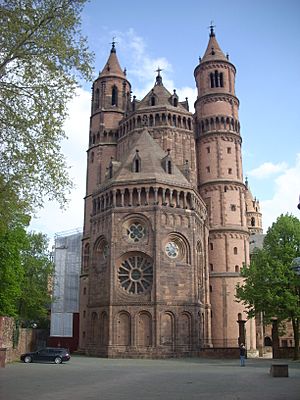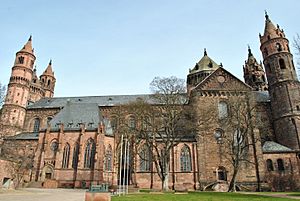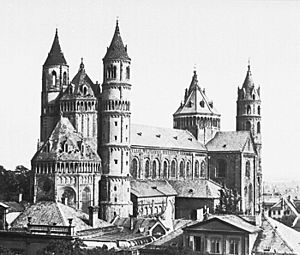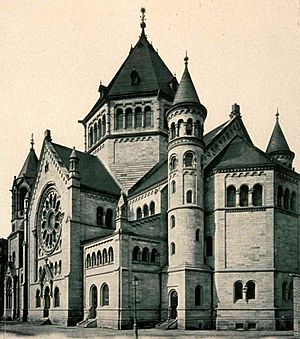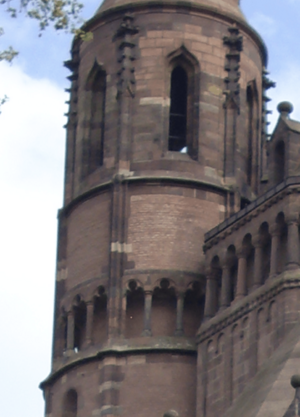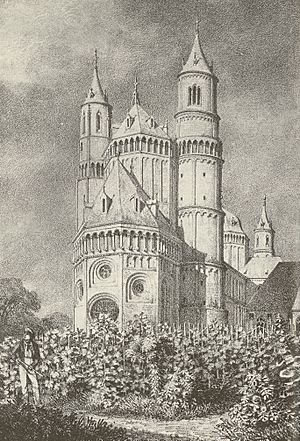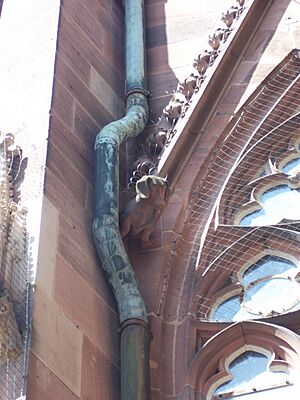Worms Cathedral facts for kids
Quick facts for kids Worms Cathedral |
|
|---|---|
| St. Peter's Cathedral | |
|
Wormser Dom
|
|
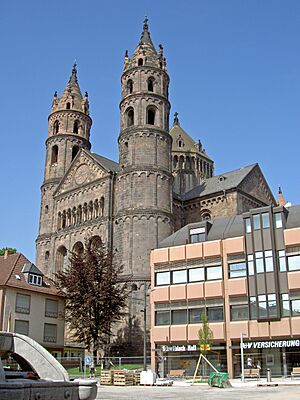
The east end of the Cathedral.
|
|
| 49°37′49″N 8°21′35″E / 49.63028°N 8.35972°E | |
| Location | Worms, Rhineland-Palatinate |
| Country | Germany |
| Denomination | Roman Catholic |
| History | |
| Former name(s) | Cathedral Church of St. Peter of Worms |
| Founder(s) | Berthulf of Worms |
| Architecture | |
| Previous cathedrals | 2 |
| Architectural type | Romanesque |
| Years built | 1130–1181 |
| Specifications | |
| Nave height | 26 m (85 ft) |
| Number of spires | 4 |
| Bells | 8 |
| Tenor bell weight | 2,855 kg (6,294 lb) |
| Administration | |
| Diocese | Mainz |
| Province | Freiburg |
St Peter's Cathedral (German: Wormser Dom) is a large Roman Catholic church in Worms, southern Germany. It used to be a cathedral, which means it was the main church for a bishop.
This impressive building stands on the highest point in Worms. It is a very important example of Romanesque style. The cathedral is strongly connected to Bishop Burchard and the city's golden age in the 12th and 13th centuries. It was the center of the Catholic Prince-Bishopric of Worms until 1802. After that, it became a regular parish church, but in 1925, Pope Pius XI gave it the special title of minor basilica.
Most of the cathedral was finished by 1181. However, parts like the west choir and the vaulted ceilings were added in the 13th century. The detailed south entrance was built in the 14th century, and the main dome has been rebuilt over time.
Many important events happened at the cathedral. In 1048, Leo IX was chosen as Pope here. The Concordat of Worms in 1122, which ended a big argument about who could appoint church leaders, also took place here. Emperor Frederick II married Isabella of England in 1235 at the cathedral. Perhaps the most famous event was the Diet of Worms in 1521, where Martin Luther was declared a heretic.
Contents
History of Worms Cathedral
Early Buildings on the Hill
The cathedral stands on the highest hill in Worms. This spot was safe from floods, so people have lived here for thousands of years. First came the Celts, then the Germanic tribe called the Vangiones. The Romans later took over, building a trading center and temples on the hill.
The Roman Empire declined, and their soldiers left Worms in 401. The Burgundians then settled in Worms, tasked by the Romans to protect the borders. They tried to break free from Roman rule but were defeated in 435. A year later, the Huns attacked, causing great destruction.
The First Churches
After a major battle, the Franks moved into the Rhine valley and took control of Worms. They also became Christians. Around 600 AD, Brunichildis, a Frankish queen, lived in Worms. Medieval stories say she and her successor, Dagobert I, built a church on the old Roman forum site. This church was an early version of the cathedral.
Archaeologists haven't found direct proof of this specific church. However, excavations in the early 1900s suggest a larger church was built later, likely during the Carolingian period. It's not clear if this was an expansion of an earlier building or a completely new one.
Bishop Burchard's Cathedral
Berthulf was the first known Bishop of Worms in 614. A new, larger church, similar in size to the current building, began construction under Bishop Burchard of Worms in the early 11th century. He convinced the Salian rulers to move their fort, allowing him to build the Paulus Stift nearby. The old cathedral was torn down as the new one was built.
This new church was a cross-shaped basilica with two rounded ends, facing east and west. In 1018, the cathedral was officially opened with the Emperor present. Sadly, the western part collapsed just two years later and had to be rebuilt. The church had a flat wooden roof. Records from the 1030s and 1040s describe Burchard's cathedral as very grand, with mentions of columns that had golden tops.
Only the foundations of the west towers and a treasury building from the late 11th century survived later changes. In 1110, the cathedral was officially opened for a second time, likely after more repairs.
The Current Cathedral's Construction
The major rebuilding in the 12th century created the cathedral we see today. Around 1130, Bishop Burchard II started tearing down the old church and building a new one, probably because of more damage. He completed the eastern part, including the dome and transept (the arms of the cross shape), by about 1144.
His successors, Conrad I and Conrad II, built the nave (the main part of the church) and the western choir and towers between 1160 and 1181. Conrad II officially opened the completed cathedral on May 2, 1181. This construction period was at the same time as the first phase of Gothic style. Worms Cathedral used pointed arch rib vaults, which were new for the time.
However, the overall design of the church was still very traditional, or "Romanesque." All the doors, windows, and arches in the side aisles have rounded arches. This mix of new vaulted ceilings with older Romanesque walls makes the cathedral a great example of the Late Romanesque style.
The western choir has a unique polygonal (many-sided) shape, both inside and out. It was one of the first major churches to use this design, and it even influenced later French Gothic churches. The top parts of the towers were built after the main church was finished and show some Gothic details.
Many other religious buildings in the area copied the cathedral's style, creating a "Worms Style." The cathedral's overall look also resembles the important imperial cathedrals in Speyer and Mainz.
Later Changes and Renovations
About a hundred years after the cathedral's third opening, the Chapel of St Nicholas was started. A new south entrance was built, and two more chapels for St Anne and St George were added in the early 1300s.
In 1429, the northwestern tower was damaged by an earthquake. It was rebuilt by 1472, keeping its original shape but adding Gothic details. This was an early example of "conserving restoration," meaning they tried to restore it to its original look. However, they used different materials, like brick, for nearly half of the outer walls.
The Aegidius chapel (now St Mary chapel) was built next to the north aisle around 1480-1485.
Towards the end of the 15th century, under Bishop Johann von Dalberg, the old Romanesque cloisters (covered walkways) were updated. Five large late Gothic stone carvings showing scenes from the life of Jesus were created. These are now in the north side-aisle of the cathedral. They show the Tree of Jesse (1488), the Annunciation (1487), the birth of Christ (1515), the entombment (around 1490), and the resurrection (around 1490). A sixth carving of the crucifixion was likely lost in 1689.
From Reformation to Revolution
The Diet of Worms in 1521 was a very important event for the diocese and cathedral. Soon after, some churches in Worms adopted the teachings of Martin Luther. By 1556, all churches in the Palatinate region became Protestant.
During the Thirty Years War, Swedish troops occupied Worms from 1632 to 1635, and the cathedral was used for Protestant services.
In the Nine Years War, King Louis XIV ordered the destruction of cities like Heidelberg, Mannheim, Speyer, and Worms. Churches were looted, and though the cathedral was not blown up, it was badly damaged by fire. Bishop Franz Ludwig von Pfalz-Neuberg had it restored in 1698. Some baroque features, like the windows of the silver chamber and the high altar by Balthasar Neumann, date from this time.
The cathedral's restoration was undone by French Revolutionary troops. In late 1792, they looted Speyer, Worms, Mainz, and Frankfurt. The cathedral was even used as a stable and a tavern. Between 1818 and 1830, the cloisters were torn down, and their stones were sold off.
Modern Renovations
A full renovation of St Peter's Cathedral began in 1886. The west choir had to be completely rebuilt due to structural problems and fire damage from 1689. Workers tried to reuse as many original stones as possible. On the outside, almost all the old stones are in their original places. Inside, large flat stones were used and carefully put back together. The general renovations, which also included the Chapel of St Nicholas and a new crypt for the Salian tombs, were finished in 1935.
During the renovation, in 1920, the head architect, Philipp Brand, was on scaffolding when a dachshund dog tried to bite his leg. He moved aside, and a falling stone missed him but killed the dog. As a small memorial, a statue of the dachshund was placed in the upper left corner of the south portal.
In the Allied bombings of February and March 1945, the cathedral's roof burned, but the main structure and vaults remained intact.
Architecture of Worms Cathedral
The cathedral is a pier-basilica, meaning it has strong pillars supporting the roof. It has two choirs (areas for the clergy) and a transept (the arms of the cross shape). A central tower sits over the crossing, and another over the western choir. Both choirs have two round staircase towers next to them. The nave (main aisle) has rib vaulting, while the side aisles have groin vaults. The apse (rounded end) of the west choir is octagon-shaped and decorated with rosette windows.
Glass Windows
Sadly, none of the original Medieval glass windows survived the Oppau explosion on September 21, 1921.
The current glass windows are quite varied. Some are simple clear or milky glass. Others are complex pictorial windows, especially in the chapels. For example, the Chapel of Mary has colorful windows by Heinz Hindorf (1986–1988) showing scenes from Mary's life. The Geschichtsfenster (History Window) in the Chapel of St George (1992) shows 20 scenes from the history of the Worms diocese, from the first bishop in 345 to the city's destruction in Second World War. One unusual window even shows the Biblis Nuclear Power Plant as the Tower of Babel, as an example of human mistakes.
Burials in the Cathedral
Royal Tombs in the Crypt
Four Salian princes were buried in the altar area of an earlier church and later covered over. Five more were buried there by 1046. These are ancestors and relatives of Emperor Conrad II:
- Conrad the Red, Duke of Lorraine (Great-grandfather) died 955
- Judith, Duchess of Carinthia (Grandmother) died 991
- Henry, Count of Wormsgau (Father) died 990/991
- Judith (Sister) died 998
- Conrad I, Duke of Carinthia (Uncle) died 1011
- Matilda (wife of Conrad I) died 1031/32
- Queen Matilda died 1034, wife of Henry I of France and daughter of Conrad II (moved to Worms in 1046)
- Conrad II, Duke of Carinthia (Cousin, son of Conrad I) died 1039
- Bishop Azecho, who followed Bishop Burchard, died 1044.
These sarcophagi (stone coffins) have been in a special crypt since the early 1900s. Since the floor of the transept and east choir is very high, it's clear there was always a crypt below.
Other Graves
Many other grave monuments, gravestones, and grave plates are found in the cathedral. These include:
- Reinbold Beyer of Boppard (died 1364)
- Dietrich of Bettendorf (1518–1580), Bishop of Worms
- Wilhelm of Efferen (1563–1616), Bishop of Worms
- Eberhard of Heppenheim (died 1559), a Canon
- Franz Rudolph of Hettersdorf (1675–1729), Canon and donor
- Johann Adam of Hoheneck (died 1731), Deacon of Worms
- Johann Franz Jakob Anton of Hoheneck (1686–1758), Canon
- Landolf of Hoheneck (died 1247), Bishop of Worms (later monument from 1756)
- Christoph Jodok of Ketteler (1661–1735), Canon
- Philipp of Rodenstein (1564–1604), Bishop of Worms
- Georg of Schönenberg (1530–1595), Bishop of Worms
- Burchard II, also called Bucco or Buggo (died 1149), Bishop of Worms and builder of the eastern part of the cathedral.
Chapel of St Nicholas
During the third building phase, an early Romanesque chapel honoring St Nicholas of Myra was built and opened in 1058. Its dedication inscription and the tympanum (a carved panel above the door) with one of the oldest images of St Nicholas are still preserved. It seems this chapel held a relic (a holy object) of the Saint, brought by Empress Theophanu from Byzantium in 972.
The current Chapel of St Nicholas was built in the same spot between 1280 and 1315 in the Gothic style. It has two aisles and is located just west of the main entrance on the south side of the cathedral. At that time, St Nicholas was very popular, seen as a patron saint for many groups and a helper in many situations. This might explain why the chapel is so large and fancy.
A Jesuit scholar named Daniel Papebroch saw the original Worms relic of St Nicholas in 1660. He described it as a "finger bone" of the saint, which was kept in the cathedral's sacristy but used to be displayed in its own chapel. He also noted that the relic was always kept in oil, just like the St Nicholas relic in Bari today. The old relic was lost during the destruction in the Nine Years War. In the late 20th century, a new relic was acquired and is now kept in the chapel in a modern container.
The chapel was originally part of the cloisters, which hid half of it. When the cloisters were finally removed in 1830, the chapel became unstable. So, between 1920 and 1927, it had to be completely taken apart, new foundations were laid, and it was rebuilt. At this time, they also made the chapel a bit longer to the west to improve its look after the cloisters were gone. The current south entrance to the chapel is modern, but its tympanum comes from the old entrance that led from the cloisters into the chapel.
Today, the Chapel of St Nicholas has items that were originally meant for other places. The Gothic carved altar came from Southern Germany. The late Gothic Baptismal font was originally in the Johanneskirche, a church that was torn down in the 19th century. The chapel's deep blue and red windows create a special, almost mystical light. The upper part of the chapel's roof holds a collection of architectural decorations, while the cellar contains the cathedral's heating system. The chapel now serves as the cathedral's baptismal chapel and is used for weekday services.
High Altar

Franz Ludwig of Pfalz-Neuburg, a powerful church leader, left money in his will for a new high altar. His successor, Franz Georg of Schönborn, asked his brother Friedrich, the Bishop of Würzburg, to get the famous builder Johann Balthasar Neumann for the project. Neumann then created the beautiful new high altar from gilded wood and colorful marble.
Organs
Main Organ (Klais 1985)
The Klais company built a large swallow's nest organ in 1985. It has three keyboards and 34 stops (different sounds). It was slightly changed and re-tuned in 2007. The organ has mechanical keys, but the tracker action (how the keys connect to the pipes) is electronic.
Choir Organ (Oberlinger 1996)
There is also a smaller choir organ built in 1996 by Oberlinger. It has mechanical keys and a tracker action, designed in the style of organs by Aristide Cavaillé-Coll. This organ is special because it's very compact for its size. It can even be moved about 50 centimeters away from the wall. This compact design was needed so the organ wouldn't block the view of the high altar from the main part of the church. The design was a team effort between Wolfgang Oberlinger, the organ master, and the diocese's architects.
Bells
Before Worms was destroyed in 1689 during the Nine Years War, the cathedral had six bells in its four towers. In 1728, the cathedral received a new set of six bells. However, these bells were taken away during the Secularisation period in the late 18th century. When the cathedral became a parish church, four bells were hung in the southeast tower. These were destroyed by bombs at the end of the Second World War.
In 1949, three new bells were cast by Albert Junker of Brilon to replace the lost ones. They were named after Peter and Paul (the cathedral's patron saints), the Blessed Virgin Mary, and Saint Conrad of Parzham (also known as Brother Conrad). These bells were blessed on Easter Sunday 1949 and hung in the south-east tower.
To celebrate the cathedral's 1000th anniversary in 2018, five new bells were added, and the old bells received new clappers. The new bells were tuned to match other church bells in the city, like those at Holy Trinity Church and St. Magnus' Church. This allows for a larger "City peal" when all three churches ring their bells together.
All the new bells were cast by the Rincker Bell Foundry. The names and inscriptions on the bells were designed by local artist Klaus Krier. The first official ringing of all eight bells, followed by the City peal, happened on May 19, 2018.
| No. |
Name |
Year |
Founder |
Weight (kg) |
Diameter
(mm) |
Key and Nominal | Inscription
(with English translation) |
Tower |
|---|---|---|---|---|---|---|---|---|
| 1 | Amandus und Rupert | 2018 | Rincker, Sinn | 2855 | 1649 | B0 −4 | Heiliger Amandus – Patron der Stadt Worms und Heiliger Rupert – Großer Missionar – Heilige Bischöfe von Worms – Bittet für die Kirche und ihre Hirten
Saint Amandus – Patron of the City of Worms and Saint Rupert – The Great Missionary – Holy Bishop of Worms – Pray for the Church and her Ministers |
North-East |
| 2 | Petrus und Paulus | 1949 | Junker, Brilon | 2218 | 1580 | C1 −4 | Petrus und Paulus – beschützt die Stadt Worms
Peter and Paul – Protect the City of Worms |
South-East |
| 3 | Heinrich und Kunigunde | 2018 | Rincker, Sinn | 1789 | 1405 | D1 −2 | Heiliger Heinrich und Heilige Kunigunde – Herrscher des römischen Reiches und Freunde Bischof Burchards – Betet für die, die uns regieren – um Frieden zwischen den Völkern
St. Henry and St. Kunigunde – Ruler of the (Holy) Roman Empire and Friends of Bishop Burchard – Pray for them that govern us – for peace among the people |
North-East |
| 4 | Maria | 1949 | Junker, Brilon | 1114 | 1260 | E1 −2 | Maria – Dein Hilf wir all begehren.
Mary – For thy help, we pray. |
South-East |
| 5 | Bruder Konrad | 653 | 1060 | G1 −1 | Hl. Bruder Konrad – bitte für uns. Gestiftet von Karl Kübel und Ehefrau.
St. Brother Conrad – Pray for us. Donated by Karl Kübel and his wife. |
South-East | ||
| 6 | Petrus Faber SJ | 2018 | Rincker, Sinn | 556 | 947 | A1 −1 | Heiliger Petrus Faber SJ – Kämpfer für Versöhnung und Ökumene – „Dass alle eins seien“ – Um die Einheit der Kirche
Saint Peter Faber SJ – Fight for Reconciliation and Ecumenism – "That all may be one" – For the Unity of the Church |
South-East |
| 7 | Heribert | 473 | 880 | B1 −1 | Heiliger Heribert – Bischof – Kanzler – Freund der Armen – Dass wir die Armen und Schwachen nicht vergessen – Bitte für uns
Saint Heribert – Bishop – Chancellor – Friend of the Poor – That we may not forget the poor and the weak – Pray for us |
North-East | ||
| 8 | Hanno von Worms | 297 | 751 | D2 +1 | Heiliger Hanno von Worms – Frommer Ordensmann und weiser Bischof – Bitte für unsere Kranken und die Sterbenden
Saint Hanno of Worms – Pious, Religious and wise Bishop – Pray for our Sick and the Dying |
North-East |
The Cathedral in the Nibelungen Saga
A famous scene from the Nibelungenlied, an old German epic poem, takes place at the cathedral's entrance. The rival queens Brünhilde and Kriemhild argue about whose husband (Siegfried or Gunther) is more important. This argument leads to Siegfried's death and the destruction of the Nibelungs.
The entrance mentioned in the story was on the north side of the cathedral. It was much more detailed before it was destroyed in 1689.
Because of this story, the Nibelungenfestspiele (Nibelungen Festival) has been held on an outdoor stage in front of the cathedral every year since 2002.
See also
 In Spanish: Catedral de Worms para niños
In Spanish: Catedral de Worms para niños
- The New Synagogue of Strasbourg, built from 1895 to 1898, was designed to look like Worms Cathedral.
- Mainz Cathedral


